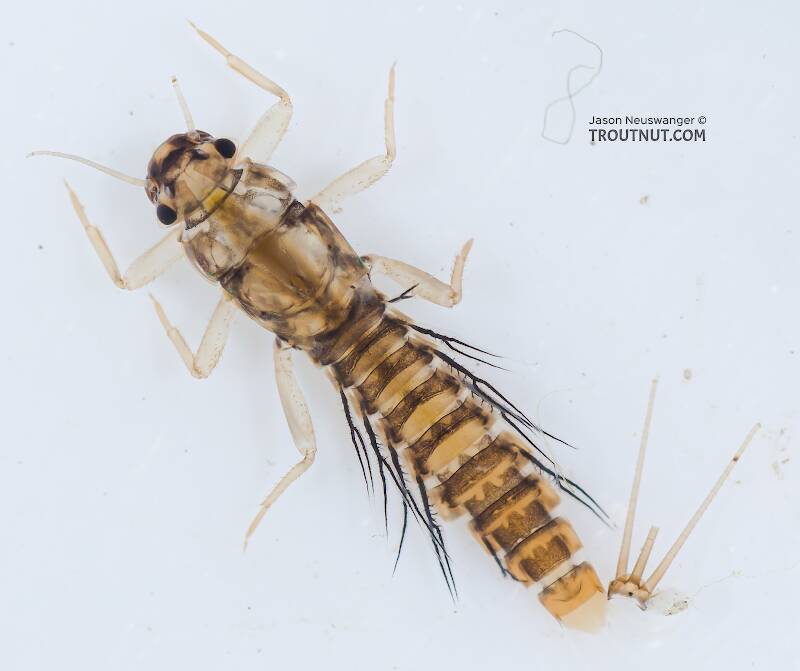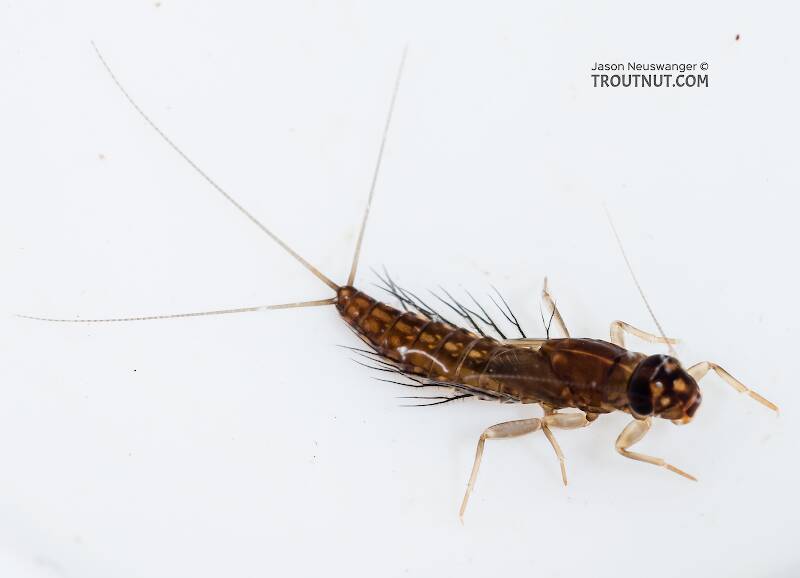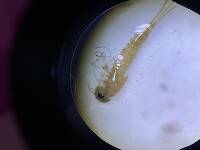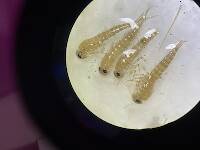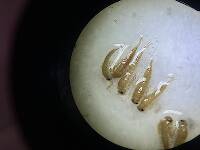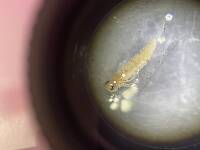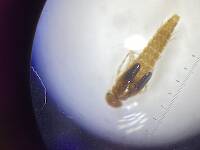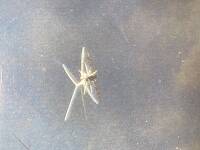
Blue-winged Olives
Baetis
Tiny Baetis mayflies are perhaps the most commonly encountered and imitated by anglers on all American trout streams due to their great abundance, widespread distribution, and trout-friendly emergence habits.
Featured on the forum

This is a striking caddis larva with an interesting color pattern on the head. Here are some characteristics I was able to see under the microscope, but could not easily expose for a picture:
- The prosternal horn is present.
- The mandible is clearly toothed, not formed into a uniform scraper blade.
- The seems to be only 2 major setae on the ventral edge of the hind femur.
- Chloride epithelia seem to be absent from the dorsal side of any abdominal segments.
Based on these characteristics and the ones more easily visible from the pictures, this seems to be Grammotaulius. The key's description of the case is spot-on: "Case cylindrical, made of longitudinally arranged sedge or similar leaves," as is the description of the markings on the head, "Dorsum of head light brownish yellow with numerous discrete, small, dark spots." The spot pattern on the head is a very good match to figure 19.312 of Merritt R.W., Cummins, K.W., and Berg, M.B. (2019). The species ID is based on Grammotaulius betteni being the only species of this genus known in Washington state.
- The prosternal horn is present.
- The mandible is clearly toothed, not formed into a uniform scraper blade.
- The seems to be only 2 major setae on the ventral edge of the hind femur.
- Chloride epithelia seem to be absent from the dorsal side of any abdominal segments.
Based on these characteristics and the ones more easily visible from the pictures, this seems to be Grammotaulius. The key's description of the case is spot-on: "Case cylindrical, made of longitudinally arranged sedge or similar leaves," as is the description of the markings on the head, "Dorsum of head light brownish yellow with numerous discrete, small, dark spots." The spot pattern on the head is a very good match to figure 19.312 of Merritt R.W., Cummins, K.W., and Berg, M.B. (2019). The species ID is based on Grammotaulius betteni being the only species of this genus known in Washington state.

Troutnut is a project started in 2003 by salmonid ecologist Jason "Troutnut" Neuswanger to help anglers and
fly tyers unabashedly embrace the entomological side of the sport. Learn more about Troutnut or
support the project for an enhanced experience here.
This topic is about the Mayfly Family Leptophlebiidae
The champions of this family are Leptophlebia and Paraleptophlebia, along with the relatively newly-defined genus Neoleptophlebia containing several important species that were once in Paraleptophlebia. The large mayflies of Leptophlebia are on the water sporadically for a long time. The Paraleptophlebia and Neoleptophlebia flies are smaller but come in much more concentrated numbers.Leptophlebiidae also contains several genera and species which are never mentioned in fly-fishing literature, either because they are too rare or because they require water too warm for trout.
Example specimens
JasonM on Mar 6, 2010March 6th, 2010, 7:18 pm EST
I live in Arizona and I have a question...
Over the past several years I have witnessed a spectacular emergence of mayflies on a stream I frequent in the Mogollon Rim area of Arizona. The stream is a tributary to the Little Colorado River drainage.
The adults seem to emerge on exposed midstream rocks of along the shoreline. The duns can be very dense, sometimes every rock along shore has one drying its wings beforetaking flight They are a dark greyish brown bodied, dark grey winged adult, I have named them MOCHA DUNS for lack of knowledge of their true identity. Three tails on the adult as well. They are pretty big....a big size 14 to 16. I have captured several specimens as larvae that I believe are the same species as the ones I have observed as adults. The larvae have prominent gills. 3 long split tails, similar size and color, hign densities along shore and in the shallows, etc. I'm 90% sure that they are Leptophlebiidae. But I don't know the species, yet.
The trout don't seem to key in on the adults...since they emerge on land...but I have experienced some incredible fishing during very windy days while the hatch is on. The nymphs appear to have trouble holding on to the substrates they are trying to emerge on. I have witessed several swimming to a streamside cobble, grasping the rock for a moment, only to be swepped back into the water by small, lapping waves being caused by the wind. They try repeatedly but seem to get exhausted pretty quickly. They must be easy picking for fish cruising along the bank, as I have great success fishing imitations along the shore with short twitches. I have rarely seen duns on the surface of the stream, even on the windiest of days. They seem to emerge late morning to early afternoon.
CAN ANYBODY SUGGEST WHAT SPECIES THIS MAYBE. I don't have a scope or any literature anymore. I have experience with ID'ing but not lately
Any help would be appreciated by this inquisitive angler. Thanks
Jason Mszaros
The Drag Free School of Fly Fishing
928-273-9445
Over the past several years I have witnessed a spectacular emergence of mayflies on a stream I frequent in the Mogollon Rim area of Arizona. The stream is a tributary to the Little Colorado River drainage.
The adults seem to emerge on exposed midstream rocks of along the shoreline. The duns can be very dense, sometimes every rock along shore has one drying its wings beforetaking flight They are a dark greyish brown bodied, dark grey winged adult, I have named them MOCHA DUNS for lack of knowledge of their true identity. Three tails on the adult as well. They are pretty big....a big size 14 to 16. I have captured several specimens as larvae that I believe are the same species as the ones I have observed as adults. The larvae have prominent gills. 3 long split tails, similar size and color, hign densities along shore and in the shallows, etc. I'm 90% sure that they are Leptophlebiidae. But I don't know the species, yet.
The trout don't seem to key in on the adults...since they emerge on land...but I have experienced some incredible fishing during very windy days while the hatch is on. The nymphs appear to have trouble holding on to the substrates they are trying to emerge on. I have witessed several swimming to a streamside cobble, grasping the rock for a moment, only to be swepped back into the water by small, lapping waves being caused by the wind. They try repeatedly but seem to get exhausted pretty quickly. They must be easy picking for fish cruising along the bank, as I have great success fishing imitations along the shore with short twitches. I have rarely seen duns on the surface of the stream, even on the windiest of days. They seem to emerge late morning to early afternoon.
CAN ANYBODY SUGGEST WHAT SPECIES THIS MAYBE. I don't have a scope or any literature anymore. I have experience with ID'ing but not lately
Any help would be appreciated by this inquisitive angler. Thanks
Jason Mszaros
The Drag Free School of Fly Fishing
928-273-9445
howdy
Taxon on Mar 6, 2010March 6th, 2010, 7:45 pm EST
JasonM-
What month of the year does this emergence seem to peak?
If it's some time between mid-June and mid-July, my guess would be Paraleptophlebia memorialis.
Here is a detailed description:
Family: Leptophlebiidae
Scientific name: Paraleptophlebia memorialis
Previously know as: Leptophlebia memorialis, Leptophlebia pallipes (in part), Paraleptophlebia pallipes
Common name: Mahogany Dun, etc.
Locality: W
CAN Regions: NW
MEX Regions: SW
USA Regions: NW, SW
Cent. Amer. Countries:
CAN Provinces: AB, BC.
MEX States: BN.
USA States: AZ, CA, CO, ID, NM, OR, SD, UT, WA
Habitat:
Voltinism:
Emergence (begin) date: mid-Jun
Emergence (end) date: early-Aug
Emergence time of day: afternoon
Spinner fall time of day:
Nymph minimum length: 6 mm.
Nymph maximum length: 7 mm.
Nymph identification keys: gill fork 1/3 from base; abdominal spines on segment 8 & 9; tergites dark, each w/three light dots, a medium-sized one on center-line, and a small-sized one forward on each side of center-line
Nymph body description:
Nymph legs:
Nymph gills: gill/filament length ratio (1:3), trachael branching: (absent)
Nymph tusks: absent
Nymph tails: 3,
Dun minimum length: 6 mm.
Dun maximum length: 8 mm.
Dun identification keys:
Dun body description: brown to dark reddish brown
Dun wings: medium gray, hind wings w/o costal angulation
Dun legs: brown
Dun tails: 3, light to dark brown
Spinner minimum length: 7 mm.
Spinner maximum length: 7 mm.
Spinner identification keys: male claspers w/3 joints
Spinner body description: abdomen whitish
Spinner wings: hyaline, fore wing with attached intercalaries, hind wing w/o costal angulation
Spinner legs:
Spinner tails: 3,
What month of the year does this emergence seem to peak?
If it's some time between mid-June and mid-July, my guess would be Paraleptophlebia memorialis.
Here is a detailed description:
Family: Leptophlebiidae
Scientific name: Paraleptophlebia memorialis
Previously know as: Leptophlebia memorialis, Leptophlebia pallipes (in part), Paraleptophlebia pallipes
Common name: Mahogany Dun, etc.
Locality: W
CAN Regions: NW
MEX Regions: SW
USA Regions: NW, SW
Cent. Amer. Countries:
CAN Provinces: AB, BC.
MEX States: BN.
USA States: AZ, CA, CO, ID, NM, OR, SD, UT, WA
Habitat:
Voltinism:
Emergence (begin) date: mid-Jun
Emergence (end) date: early-Aug
Emergence time of day: afternoon
Spinner fall time of day:
Nymph minimum length: 6 mm.
Nymph maximum length: 7 mm.
Nymph identification keys: gill fork 1/3 from base; abdominal spines on segment 8 & 9; tergites dark, each w/three light dots, a medium-sized one on center-line, and a small-sized one forward on each side of center-line
Nymph body description:
Nymph legs:
Nymph gills: gill/filament length ratio (1:3), trachael branching: (absent)
Nymph tusks: absent
Nymph tails: 3,
Dun minimum length: 6 mm.
Dun maximum length: 8 mm.
Dun identification keys:
Dun body description: brown to dark reddish brown
Dun wings: medium gray, hind wings w/o costal angulation
Dun legs: brown
Dun tails: 3, light to dark brown
Spinner minimum length: 7 mm.
Spinner maximum length: 7 mm.
Spinner identification keys: male claspers w/3 joints
Spinner body description: abdomen whitish
Spinner wings: hyaline, fore wing with attached intercalaries, hind wing w/o costal angulation
Spinner legs:
Spinner tails: 3,
Quick Reply
Related Discussions
Topic
Replies
Last Reply
1
Sep 9, 2008
by GONZO
by GONZO
0
May 3, 2007
by Troutnut
by Troutnut


